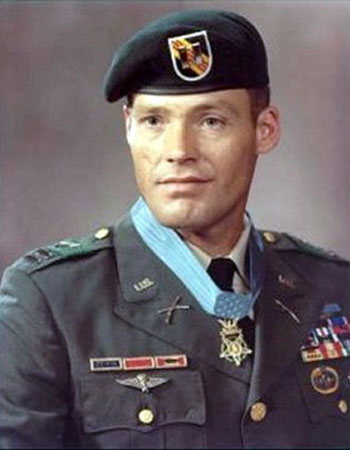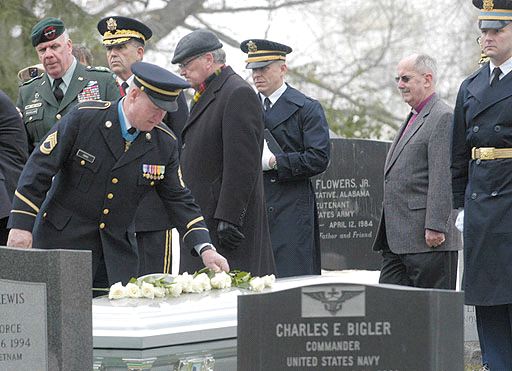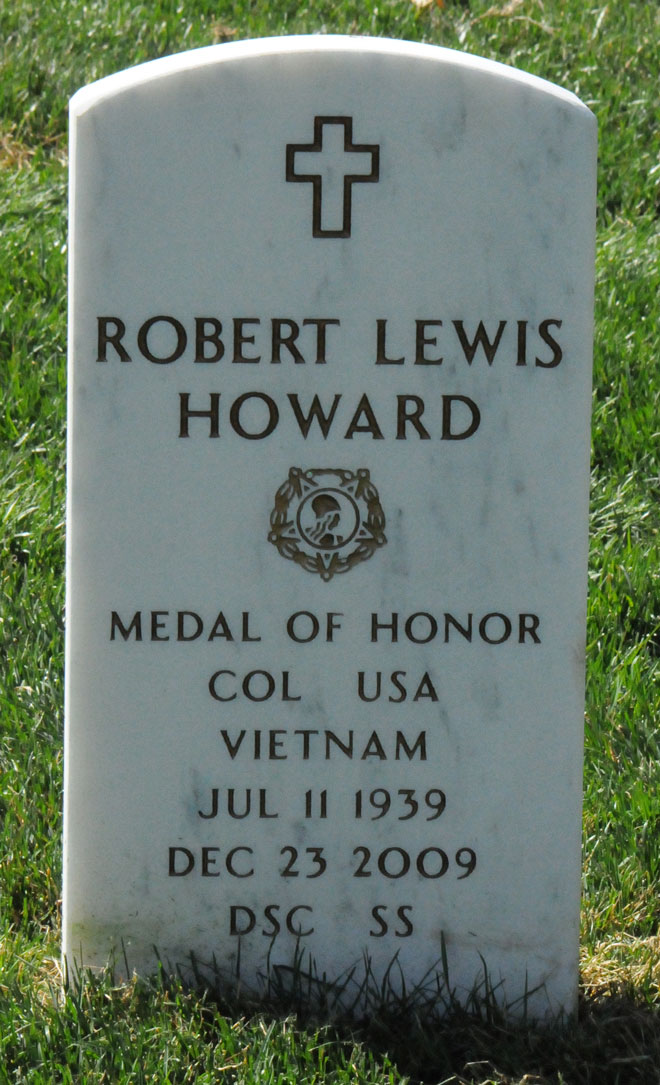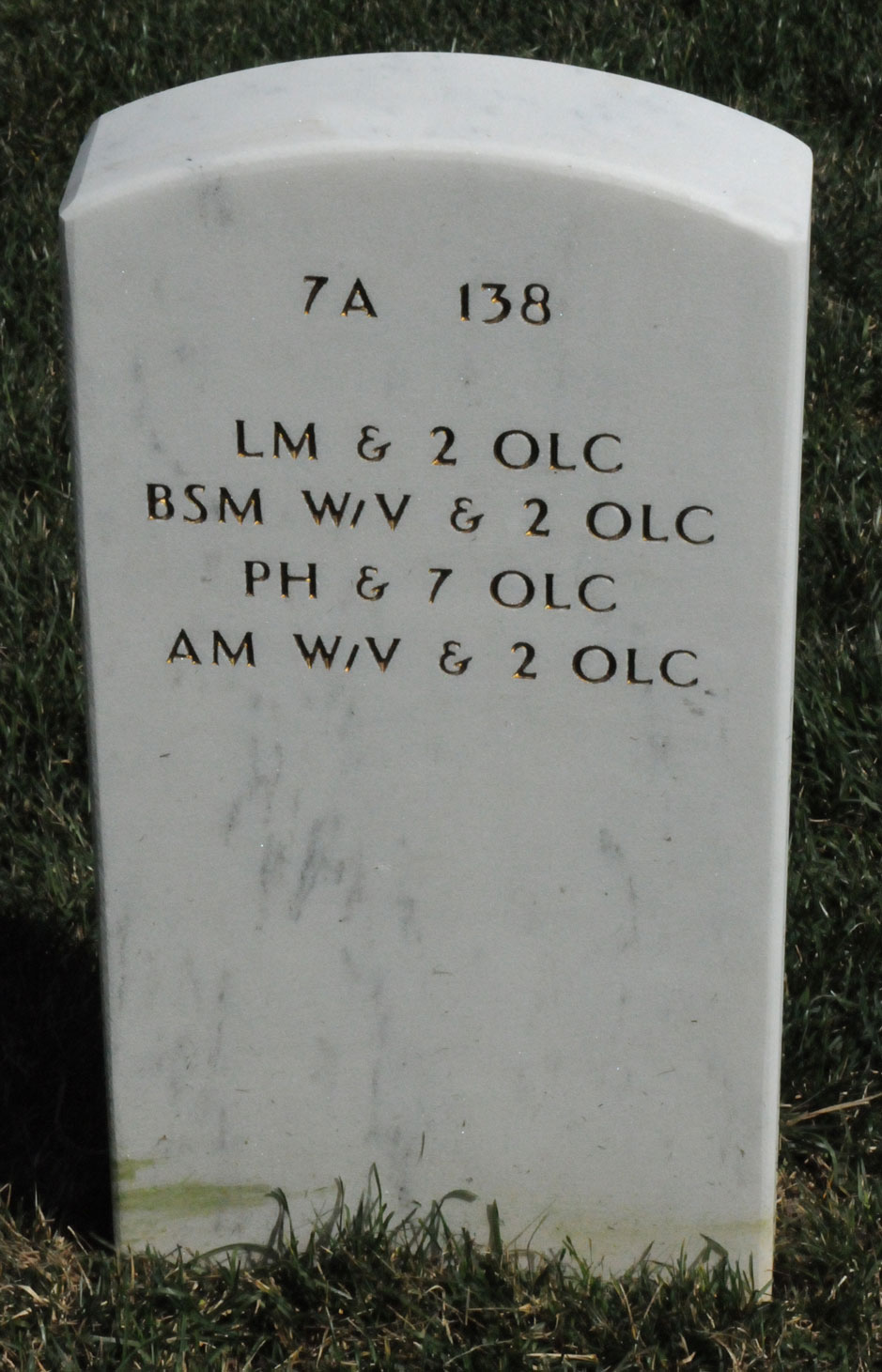
December 23, 2009) – Retired Army Colonel Robert L. Howard, 70, who died Wednesday in Waco, Texas, was a Medal of Honor recipient who at the time of his death was believed to be the most-decorated living American soldier.
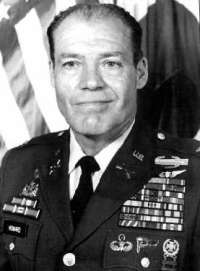
Howard will be buried at Arlington National Cemetery.
Services were pending Wednesday through Oak Crest Funeral Home in Waco.
Texas Governor Rick Perry issued a statement late Wednesday afternoon in which he said Howard “was the bravest soldier I ever met.”
“His unshakeable commitment to freedom, displayed in countless episodes of battlefield gallantry, lives on in the actions of our military men and women who continue to serve in hostile conditions overseas,” he said.
Howard, who grew up in Opelika, Alabama, enlisted in the Army in 1956 at the age of 17 and retired as a full Colonel in 1992.
In Vietnam, he served in the U.S. Army Special Forces and spent most of his five tours in the secret Military Assistance Command, Vietnam-Studies and Observation Group, or MACV-SOG, which was an unconventional force whose members were assigned to deep-penetration reconnaissance and interdiction missions.
He was nominated three times for the Medal of Honor, which he was awarded in 1971 for the rescue of a seriously wounded platoon leader who was under enemy fire.
During his 54 months of combat duty in Vietnam, Howard was wounded 14 times and was awarded eight Purple Heart Medals.
He leaves behind his children, Denicia Howard of Florida, Melissa Gentsch and husband, Waco Assistant Chief of Police Frank Gentsch of Waco, Rosslyn Howard of California and Robert Howard, Jr. and his wife, Tori of California.
Howard entered the Army at Montgomery, Alabama and retired as Colonel.
As a staff sergeant of the highly-classified Military Assistance Command, Vietnam – Studies and Observations Group (MACV-SOG), Howard was recommended for the Medal of Honor on three separate occasions for three individual actions during thirteen months spanning 1967-1968. The first two nominations were downgraded to the award of the Distinguished Service Cross due to the covert nature of the operations in which Howard participated. As a Sergeant First Class of the same organization, he risked his life during a rescue mission in Cambodia on December 30, 1968, while second in command of a platoon-sized Hornet force that was searching for missing American soldier Robert Scherdin, and was finally awarded the Medal of Honor.
While leading a covert SOG platoon-sized mission in southeastern Laos on November 16, 1967, Sergeant First Class Howard carried out actions that led to his being recommended for his nation’s highest honor. While the main body destroyed an enemy cache, Howard’s team came upon four North Vietnamese Army soldiers, whom he shot. The team was then pinned down by heavy machine gun fire. Howard first eliminated a sniper and then charged the machine gun position, killing its occupants. When a second machine gun opened up, he crawled forward to within point-blank range and threw a hand grenade, disabling that gun.
When more of the North Vietnamese took over the same gun, Howard stood in the open and fired a light anti-tank weapon, knocking it out once again. The team was then successfully extracted by helicopter. Although recommended for the Medal of Honor, Howard’s award was downgraded to the Distinguished Service Cross. This would be the first of three recommendations within 13 months for the Medal of Honor for Robert Howard.
In mid-November Howard accompanied an FOB-2 Hatchet Platoon into Laos. After four days in the area, on November 19, 1968, the force was ambushed by Vietnamese troops, including a Soviet-built PT-76 tank. Braving intense fire, Howard crept forward and knocked out the PT-76 with an anti-tank rocket. After a medivac helicopter was shot down, Howard, already wounded, charged forward 300 yards through North Vietnamese fire to lead the two pilots and a wounded door gunner to safety. He was again wounded, this time by 14 pieces of shrapnel, but all that this seemed to do was aggravate him.
He charged the Vietnamese, killed two and dragged back a third as a prisoner. North Vietnamese anti-aircraft fire halted the extraction of the platoon until the following morning, when Howard, already perforated multiple times, moved forward and silenced a 37 mm anti-aircraft gun, allowing the extraction to be completed. For the second time, Howard was recommended for the Medal of Honor, but his award was again downgraded to a Distinguished Service Cross.
This series of events illustrates the difficulties faced when special operations personnel exhibited extraordinary bravery in denied areas. Recommendations for decorations always stipulated the location and circumstances of the action, and since the award of such a high decoration became public knowledge, the citation would have to be changed to place the action within territorial South Vietnam. The U.S. Congress and President were loath to create any sense of falsehood about the actions of the nation’s most highly decorated military personnel, so, in many instances, awards were downgraded to keep the recipient out of the limelight.
On December 30, 1968 Howard was serving as a member of a 40-man Bright Light rescue mission into northeastern Cambodia. The unit was in search of MACSOG Private First Class Robert Scherdin, who had been separated from his recon team. Bypassing a North Vietnamese Army company, Howard was leading his men up a hill when he and Lieutenant Jim Jerson were wounded by a land mine. While administering first aid to Jerson, a bullet struck one of the wounded man’s ammunition pouches, detonating several magazines. His fingers in shreds, Howard was dragging Jerson off the hill when he was shot in the foot.
The remaining 20 men were organized by Howard, who administered first aid, directed their fire, and encouraged them to resist. After three and one-half hours under attack, Howard prepared for a fight to the death. The team was saved from that fate, however, when an emergency night extraction took them off without any further casualties. As badly wounded as he was, Howard was the last man to board a helicopter. After his third recommendation in 13 months, Robert Howard was finally awarded a well-deserved Medal of Honor.
Perhaps no man represented the quandary of the political and moral dilemma of the Vietnam War in the heart and mind of America better than Howard. He had become arguably the most highly decorated serviceman in American military history, yet few of his countrymen even knew who he was. Unlike Alvin York or Audie Murphy before him, Howard was not touted as a national hero by the media, he was given no ticker tape parade, and no Hollywood movie was made depicting his extraordinary exploits. Of course, none of this bothered the quiet, unassuming Howard. He remained in the Army and retired as a full Colonel, after 36 years of active service, in September 1992.
It is believed by some historians that Howard is the most highly-decorated living American soldier in history. His residence was in Texas and he spent much of his free time working with veterans at the time of his death. He also took periodic trips to Iraq to visit active duty troops.
The President of the United States in the name of The Congress takes pride in presenting the MEDAL OF HONOR to
FIRST LIEUTENANT
ROBERT L. HOWARD
UNITED STATES ARMY
for service as set forth in the following CITATION:
For conspicuous gallantry and intrepidity in action at the risk of his life above and beyond the call of duty. 1st Lt. Howard (then SFC), distinguished himself while serving as platoon sergeant of an American-Vietnamese platoon which was on a mission to rescue a missing American soldier in enemy controlled territory in the Republic of Vietnam.
The platoon had left its helicopter landing zone and was moving out on its mission when it was attacked by an estimated 2-company force. During the initial engagement, 1st Lt. Howard was wounded and his weapon destroyed by a grenade explosion. 1st Lt. Howard saw his platoon leader had been wounded seriously and was exposed to fire. Although unable to walk, and weaponless, 1st Lt. Howard unhesitatingly crawled through a hail of fire to retrieve his wounded leader. As 1st Lt. Howard was administering first aid and removing the officer’s equipment, an enemy bullet struck 1 of the ammunition pouches on the lieutenant’s belt, detonating several magazines of ammunition. 1st Lt. Howard momentarily sought cover and then realizing that he must rejoin the platoon, which had been disorganized by the enemy attack, he again began dragging the seriously wounded officer toward the platoon area.
Through his outstanding example of indomitable courage and bravery, 1st Lt. Howard was able to rally the platoon into an organized defense force. With complete disregard for his safety, 1st Lt. Howard crawled from position to position, administering first aid to the wounded, giving encouragement to the defenders and directing their fire on the encircling enemy. For 3 1/2 hours 1st Lt. Howard’s small force and supporting aircraft successfully repulsed enemy attacks and finally were in sufficient control to permit the landing of rescue helicopters. 1st Lt. Howard personally supervised the loading of his men and did not leave the bullet-swept landing zone until all were aboard safely.
1st Lt. Howard’s gallantry in action, his complete devotion to the welfare of his men at the risk of his life were in keeping with the highest traditions of the military service and reflect great credit on himself, his unit, and the U.S. Army.
The President of the United States of America, authorized by Act of Congress, July 9, 1918 (amended by act of July 25, 1963), takes pleasure in presenting the Distinguished Service Cross to Sergeant First Class Robert Lewis Howard (ASN: RA-14628152), United States Army, for extraordinary heroism in connection with military operations involving conflict with an armed hostile force in the Republic of Vietnam, while serving with Command and Control (Central), 5th Special Forces Group (Airborne), 1st Special Forces.
Sergeant First Class Howard distinguished himself by exceptionally valorous actions on 21 November 1967, as Special Forces Advisor to a joint American and Vietnamese reconnaissance patrol conducting a search mission near the Laotian border. His patrol discovered a huge rice and ammunition cache surrounded by an enemy bunker complex. Sergeant Howard led a small team to provide security while the remainder of the unit began to destroy the stored supplies. His team encountered four North Vietnamese Army soldiers, and Sergeant Howard killed them with a fierce burst of rifle fire. He and his men were immediately pinned down by a murderous curtain of fire which erupted from a nearby enemy machine gun position. With complete disregard for his safety, Sergeant Howard crawled toward the emplacement and killed a North Vietnamese sniper who was firing at him as he maneuvered. He then charged the bunker, eliminating its occupants with rifle fire. A second machine gun position unleashed a savage barrage. Sergeant Howard moved his troops to a covered location and directed an air strike against the fortified bunker. While assessing the bomb damage, Sergeant Howard was fired upon by North Vietnamese soldiers in the bunker who had survived the blasts. Pinned down directly outside the strongpoint with a blazing machine gun barrel only six inches above his head, he threw a hand grenade into the aperture of the emplacement, killing the gunners and temporarily silencing the weapon. He then dashed to his team’s location and secured a light anti-tank weapon. As the enemy machine gun resumed firing, Sergeant Howard stood up amid a withering hail of bullets, fired his weapon, and completely demolished the position. His fearless and determined actions in close combat enabled the remainder of the patrol to destroy the enemy cache. Sergeant First Class Howard’s extraordinary heroism and devotion to duty were in keeping with the highest traditions of the military service and reflect great credit upon himself, his unit, and the United States Army.
Service: Army
Rank: Sergeant First Class
Headquarters, U.S. Army, Vietnam, General Orders No. 2018 (May 2, 1968)
The President of the United States of America, authorized by Act of Congress, July 9, 1918, takes pleasure in presenting the Silver Star to Sergeant First Class Robert Lewis Howard (ASN: RA-14628152), United States Army, for gallantry in action while engaged in military operations involving conflict with an armed hostile force in the Republic of Vietnam, while serving with Headquarters and Headquarters Company, 5th Special Forces Group (Airborne), 1st Special Forces.
Sergeant First Class Howard distinguished himself by exceptionally valorous actions from 12 to 20 November 1968, during an operation deep within enemy-held territory. As his platoon was being inserted into the area, it came under heavy fie from all directions. Sergeant Howard leaped from his helicopter before it touched down and began to return fire, providing protection for his men while they dismounted and moved safely off the landing zone. Seeing two enemy soldiers in a wood line, he charged their position and killed them both. When the unit was attacked by a company-size force on the night of 16 November, he went to each platoon member, encouraging them and directing their fire while completely exposing himself to the communist barrage. Two days later while Sergeant Howard was leading the point element, the platoon was ambushed by an estimated two North Vietnamese Army companies. He skillfully maneuvered his men so that the enemy was caught in a deadly crossfire and the ambush was broken. The following day, Sergeant Howard had again taken the point element when he observed an estimated battalion-size ambush. Although wounded in the initial exchange of fire, he exposed himself to the aggressors to place effective fire on them and enable his platoon to take cover. Moving from position to position, he administered first aid to the wounded and set up a landing zone so that they could be evacuated. As the first ambulance helicopter came in, it was struck by hostile machine gun fire and burst into flames. Sergeant Howard, although wounded a second time, ran one hundred and fifty meters to where the ship had crashed and rescued a trapped pilot from the blazing wreckage. Once the entire crew was free from the aircraft, he led them back to the platoon while providing covering fire. Three hours later another helicopter succeeded in landing and the casualties were evacuated, but Sergeant Howard refused to leave. The next morning, he saw three North Vietnamese soldiers maneuvering towards his element and immediately opened fire, killing them.
Service: Army
Rank: Sergeant First Class
Headquarters, U.S. Army, Vietnam, General Orders No. 371 (February 3, 1969)
Awards and decorations
- Medal of Honor
- Distinguished Service Cross (with one oak leaf cluster)
- Silver Star
- Defense Superior Service Medal
- Legion of Merit (with three oak leaf clusters)
- Bronze Star (with three oak leaf clusters and “V” device)
- Purple Heart (with a silver and two bronze oak leaf clusters)
- Meritorious Service Medal (with two oak leaf clusters)
- Air Medal (with “V” Device and numeral 3. One award for heroism and two for aerial achievement)
- Joint Service Commendation
- Army Commendation Medal (with “V” device and one each silver and bronze oak leaf clusters. 4 awards for valor and 3 for achievement)
- Joint Service Achievement
- Army Achievement
- Good Conduct Medal, 4 Good Conduct Loops (4 awards)
- National Defense Service Medal
- Armed Forces Reserve Medal
- Vietnam Service Medal
- NCO Professional Development Ribbon with 2 device
- Army Overseas Ribbon
- Army Service Ribbon
- Armed Forces Expeditionary Medal, w/3 Service stars (3 awards)
- Army Presidential Unit Citation, 1st Oak Leaf Cluster
- Presidential Unit Citation (United States) 2001, Studies and Observations Group
- Navy Unit Commendation
- Army Meritorious Unit Citation
Foreign decorations
- Vietnam Campaign Medal with 60 device
- Vietnamese Cross of Gallantry with Gold Star (Corps citation)
- Vietnamese Cross of Gallantry with Silver Star (Division citation)
- Vietnamese Cross of Gallantry with Bronze Star (Regiment or Brigade citation)
- Vietnam Armed Forces Honor Medal 2nd Award
- Vietnam Wound Medal
- Vietnam Civil Actions Medal 2nd Award
- Vietnam Cross of Gallantry Unit Citation with Palm, 1st Oak Leaf Cluster (Unit citation)
- Republic of Korea Order of National Security Merit (Samil Medal)
Badges, qualifications and tabs
- Ranger Tab
- Special Forces Tab
- Combat Infantryman Badge
- Aircrew Badge
- Master Parachutist Badge
- Pathfinder Badge
- Air Assault Badge
- Expert Infantryman’s Badge
- Vietnamese Ranger Badge
- Vietnamese Master Parachute Badge
- Thai Master Parachute Wings
- Korean Master Parachute Badge
- Thai Balloonist Badge
- French Parachutist Badge
NOTE: Colonel Howard will be buried with full military honors at Arlington National Cemetery on 22 February 2010. Services will be held at the Fort Myer Memorial Chapel at 11:00 AM. Guests should plan on arriving at 10:30 AM.
One of the nation’s most highly decorated veterans was being laid to rest on Wednesday.
Retired Colonel Robert L Howard, a Medal of Honor recipient who was awarded eight Purple Hearts for his service in the Vietnam War, was to be buried at Arlington National Cemetery in Arlington, Virginia.
Howard, who died on December 23, was 70.
Howard was wounded 14 times during 54 months of combat duty — five tours — in Vietnam. He retired from the Army as a full colonel in 2006 after 36 years in the U.S. military — including more than 33 years on airborne status.
He was hailed as one of the nation’s most heroic soldiers — and was believed to be the most highly decorated soldier since World War II.
According to a biographical sketch issued by the U.S. Army Special Forces Command (Airborne), Howard also participated in two movies starring John Wayne, making a parachute jump in “The Longest Day” and appearing as an airborne instructor in “The Green Berets.”
President Richard Nixon presented the Medal of Honor to him on March 2, 1971.
U.S. ARMY SPECIAL FORCES
COMMAND (AIRBORNE)
BIOGRAPHICAL SKETCH
U.S. ARMY SPECIAL FORCES COMMAND PUBLIC AFFAIRS OFFICE
COLONEL (RET.) ROBERT L. HOWARD
Died December 23, 2009
Colonel Robert L. Howard was born on July 11, 1939 in Opelika, Alabama. He entered military service on July 20, 1956 in Montgomery, Alabama, following in the footsteps of his father and four uncles who had served with airborne units in World War II. He was medically retired on September 30, 1992. He lived his last few years in San Antonio, Texas.
While serving with 5th Special Forces Group, he received a direct appointment from Master Sergeant to First Lieutenant in December 1969.
His 36 years of military service included more than 33 years on airborne status.
He participated in two movies concerning airborne and special operations missions, both featuring John Wayne. He made a parachute jump on the filming of The Longest Day and as an airborne instructor in The Green Berets.
Military assignments include duty with the 82nd and 101st Airborne Divisions; 2nd Ranger Battalion; 3rd, 5th, and 6th Special Forces Group; 5th Infantry Division; 7th Corps, XVIII Airborne Corps. He served in the Eighth United States Army and Combined Forces Command. Service in Vietnam included serving with 1st Bn., 327th Airborne Infantry, 1st Brigade, 101st Airborne Division and Special Forces. He was the post commander of Kelly Barracks, Stuttgart, Germany, executive officer of the 2nd Ranger Battalion, and the Mountain Ranger Camp. Howard served a total of five tours in Vietnam. As an NCO, Howard served as a demolitions sergeant. While with Special Forces, he served the majority of his time with Military Assistance Command, Vietnam – Studies and Observations Group, based out of Kontum. During his 58 months of combat, he was wounded fourteen times. Between 1968 and 1969, he was put in for three Medals of Honor. The first nomination was downgraded to Distinguished Service Cross and third to a Silver Star.
President Nixon presented the Medal of Honor to him on March 2, 1971.
Colonel Howard was a distinguished honor graduate of the Ranger Course, Pathfinder Course, and Parachute Rigger School. He received the Outstanding Infantryman’s Trophy as Outstanding Infantry Officer of Class 1979-1980 at the Command and General Staff College. He graduated from the National War College, Class 1987-1988.
His military service also contributed to exceptional civilian recognition for service to his nation. He received the Outstanding Youngman of America award 1970; nominated as one of ten Outstanding Youngmen in America in 1971 and 1972; inducted into the Military Hall of Fame, Hoover Institute, Stanford University in 1980; inducted into the Military Hall of Fame, Veterans of Foreign Wars, State of Alabama in 1973; and was promoted to Colonel for Life in 1976 by Alabama State Governor George Wallace and the Alabama State Militia.
His awards and decorations include the Medal of Honor; Distinguished Service Cross; Silver Star; Defense Superior Service Medal; Legion of Merit (three awards); Bronze Star for Valor (three awards); Purple Heart (eight awards); Meritorious Service Medal (two awards); Air Medal for Valor (two awards); Joint Service Commendation Medal; Army Commendation Medal for Valor (three awards); Joint Service Achievement Medal; Army Good Conduct Medal (four awards); National Defense Service Medal; Armed Forces Expeditionary Medal; Vietnam Service Medal; Armed Forces Reserve Medal; NCO Professional Development Ribbon; Army Service Ribbon; Overseas Service Ribbon; Vietnamese Gallantry Cross with Gold, Silver and Bronze Stars; and the Vietnam Wound Medal.
He was also authorized to wear the Army Presidential Unit Citation; Navy Valorous Unit Citation; Army Meritorious Unit Citation; Vietnamese Gallantry Unit Citation with Palm; Vietnam Armed Forces Honor Medal (two awards); Vietnam Civil Action Medal (two awards); Republic of Korea Order of National Security Merit (Samil Medal); Combat Infantryman’s Badge; Expert Infantryman’s Badge; Army Aircrew Badge; Master Parachutist Badge; Pathfinder Badge; Air Assault Badge; Vietnamese Ranger Badge; Special Forces Tab and Army Ranger Tab.
After retirement from military service in 1992, Colonel Bob Howard was employed by the Department of Veterans Affairs. He retired in January 2006 after 52 years of government service.
– DE OPPRESSO LIBER –
Thursday, February 25, 2010
MOH recipient buried at ANC
By Alex McVeigh
Courtesy of The Pentagram
Section 7A at Arlington National Cemetery houses many American heroes from many generations. Fourteen Medal of Honor recipients are interred there, as well as generals from all branches of the U.S. armed forces.
Another hero, Colonel Robert L. Howard, was laid to rest in section 7A Monday. A Medal of Honor recipient, and one of the most decorated Soldiers of the Vietnam War, Howard spent 36 years of his life serving his country as part of the Army and many years after serving veterans.
He served 58 months in combat more than five tours in Vietnam. During those tours, Howard was also awarded the Distinguished Service Corss, the Silver Star and eight Purple Hearts among many other awards.
In December 1968, then Sergeant First Class Howard, a Green Beret, was part of a group assigned to rescue another Green Beret in enemy territory. The patrol stumbled onto an ambush consisting of more than 250 enemy troops, and Howard was knocked unconscious by a mine blast.
When he came to, he noticed a lieutenant badly wounded nearby. Howard went into the line of fire to rescue the officer and was wounded again when a bullet struck his ammunition pouch, firing off several rounds.
Upon getting the lieutenant back to the group, Howard, despite being badly wounded himself, organized the platoon, directing fire toward the enemy, administering first aid and restocking them with ammunition.
This lasted three and a half hours, until the enemy was repelled enough to allow rescue helicopters to land. Howard personally supervised the evacuation of his men, not leaving until all were aboard safely.
After retiring from the military, Howard served in the Department of Veterans Affairs and was the president of the Medal of Honor Society from 2007 to 2009.
He passed away from pancreatic cancer December 23 in Waco, Texas.
More than 100 people followed the Caisson Platoon along Roosevelt Drive, which passes by the Tomb of the Unknown Soldier, to Howard’s final resting place.
A group of Soldiers from the 3rd U.S. Infantry Regiment (The Old Guard) carried the casket up the hill of section 7A. A few words of prayer were said, and the U.S. Army Band ‘‘Pershing’s Own” played ‘‘America the Beautiful” as the flag was folded and handed to Sgt. Robert L. Howard Jr., his son. Howard Jr. then handed the flag to his half-sister, Melissa Gentsch. Howard Jr. was then given a flag of his own.
In addition to Gentsch and Howard Jr., Howard was survived by two other children, Denicia and Roslyn and four grandchildren.
HOWARD, ROBERT LEWIS
- COL US ARMY
- VIETNAM
- DATE OF BIRTH: 07/11/1939
- DATE OF DEATH: 12/23/2009
- BURIED AT: SECTION 7A SITE 138
- ARLINGTON NATIONAL CEMETERY
Michael Robert Patterson was born in Arlington and is the son of a former officer of the US Army. So it was no wonder that sooner or later his interests drew him to American history and especially to American military history. Many of his articles can be found on renowned portals like the New York Times, Washingtonpost or Wikipedia.
Reviewed by: Michael Howard

